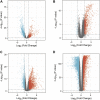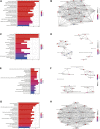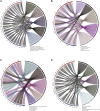Puerarin: A Potential Therapeutic for Colon Adenocarcinoma (COAD) Patients Suffering From SARS-CoV-2 Infection
- PMID: 35677450
- PMCID: PMC9168431
- DOI: 10.3389/fphar.2022.921517
Puerarin: A Potential Therapeutic for Colon Adenocarcinoma (COAD) Patients Suffering From SARS-CoV-2 Infection
Abstract
Patients with colonic adenocarcinoma (COAD) are at relatively high risk of SARS-CoV-2 infection. However, there is a lack of medical strategies to treat COVID-19/COAD comorbidity. Puerarin, a natural product, is a known antiviral, antitumor, and immunomodulatory effect. Therefore, we hypothesised that puerarin could be used to treat COVID-19/COAD patients. Based on network pharmacology and bioinformatics analysis, the potential targets and pharmacological mechanisms of puerarin in COVID-19/COAD were identified. By intersecting therapeutic target genes for puerarin, COVID-19-related genes and COAD-related genes, 42 target genes of puerarin that could potentially treat COVID-19/COAD comorbidity were obtained. By using the 42 potential target genes to construct the protein-protein interaction (PPI) network, we obtained five core target genes, namely RELA, BCL2, JUN, FOS, and MAPK1. The results of bioinformatics analysis revealed that puerarin could be able to treat COVID-19/COAD comorbidity through apoptosis, antiviral, antioxidant, NF-κB signaling pathway, MAPK signaling pathway, IL-17 signaling pathway, TNF signaling pathway, and HIF-1 signaling pathway etc. This study found that puerarin has the potential to treat COVID-19/COAD patients and that the therapeutic target genes obtained in the study may provide clues for the treatment of COVID19/COAD comorbidity.
Keywords: COAD; COVID-19; bioinformatics; comorbidity; network pharmacology; puerarin.
Copyright © 2022 Liang, Li, Yao, Meng, Wu, Wang and Xue.
Conflict of interest statement
The authors declare that the research was conducted in the absence of any commercial or financial relationships that could be construed as a potential conflict of interest.
Figures






Similar articles
-
Potential therapeutic strategies for quercetin targeting critical pathological mechanisms associated with colon adenocarcinoma and COVID-19.Front Pharmacol. 2022 Sep 29;13:988153. doi: 10.3389/fphar.2022.988153. eCollection 2022. Front Pharmacol. 2022. PMID: 36249762 Free PMC article.
-
Puerarin: A Potential Therapeutic for SARS-CoV-2 and Hantavirus Co-Infection.Front Immunol. 2022 May 19;13:892350. doi: 10.3389/fimmu.2022.892350. eCollection 2022. Front Immunol. 2022. PMID: 35663983 Free PMC article.
-
Anti-coronavirus disease 2019 (COVID-19) targets and mechanisms of puerarin.J Cell Mol Med. 2021 Jan;25(2):677-685. doi: 10.1111/jcmm.16117. Epub 2020 Nov 26. J Cell Mol Med. 2021. PMID: 33241658 Free PMC article.
-
Uncovering Active Ingredients and Mechanisms of Spica Prunellae in the Treatment of Colon Adenocarcinoma: A Study Based on Network Pharmacology and Bioinformatics.Comb Chem High Throughput Screen. 2021;24(2):306-318. doi: 10.2174/1386207323999200730210536. Comb Chem High Throughput Screen. 2021. PMID: 32748741
-
Network pharmacology analysis and experimental study strategy reveals the potential mechanism of puerarin against rotavirus.Ann Transl Med. 2022 Jan;10(1):14. doi: 10.21037/atm-21-6089. Ann Transl Med. 2022. PMID: 35242859 Free PMC article.
Cited by
-
Investigating gene signatures associated with immunity in colon adenocarcinoma to predict the immunotherapy effectiveness using NFM and WGCNA algorithms.Aging (Albany NY). 2024 May 13;16(9):7596-7621. doi: 10.18632/aging.205763. Epub 2024 May 13. Aging (Albany NY). 2024. PMID: 38742936 Free PMC article.
-
Pharmacological Activity, Pharmacokinetics, and Clinical Research Progress of Puerarin.Antioxidants (Basel). 2022 Oct 27;11(11):2121. doi: 10.3390/antiox11112121. Antioxidants (Basel). 2022. PMID: 36358493 Free PMC article. Review.
-
Bioinformatics analysis of potential pathogenesis and risk genes of immunoinflammation-promoted renal injury in severe COVID-19.Front Immunol. 2022 Aug 16;13:950076. doi: 10.3389/fimmu.2022.950076. eCollection 2022. Front Immunol. 2022. PMID: 36052061 Free PMC article.
References
LinkOut - more resources
Full Text Sources
Miscellaneous


